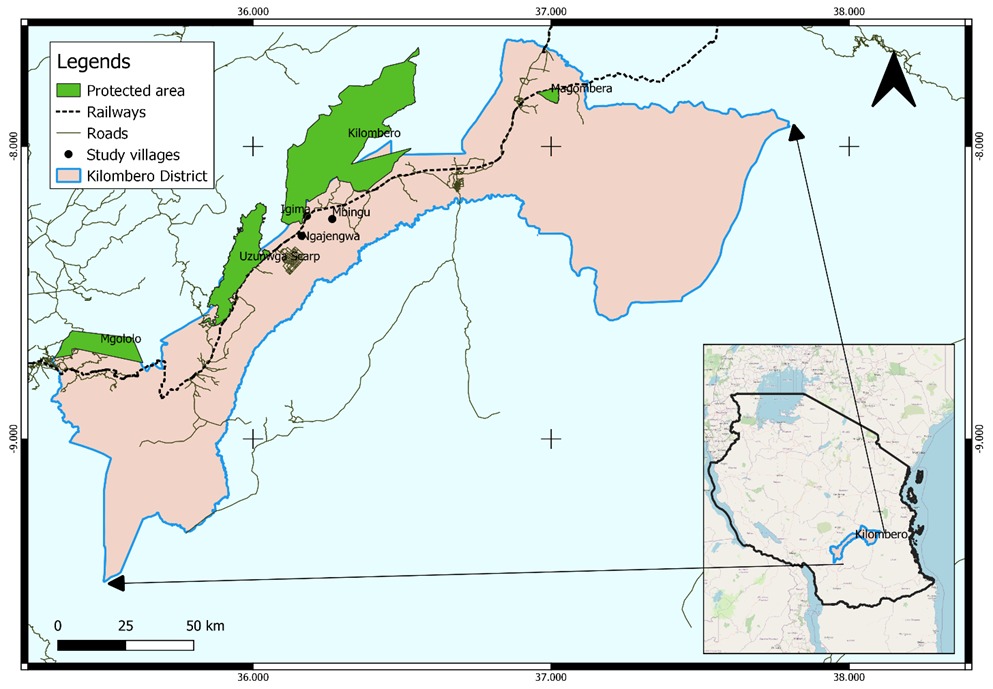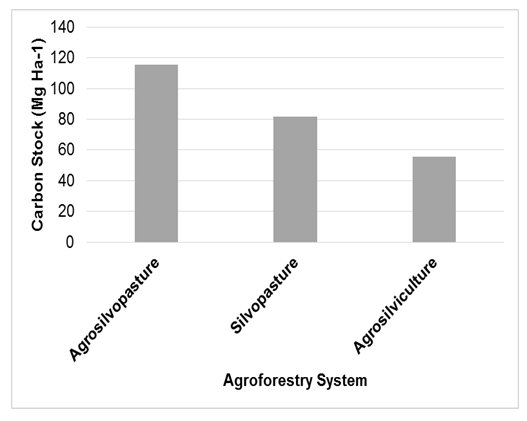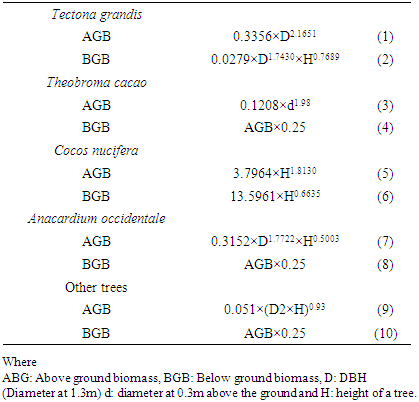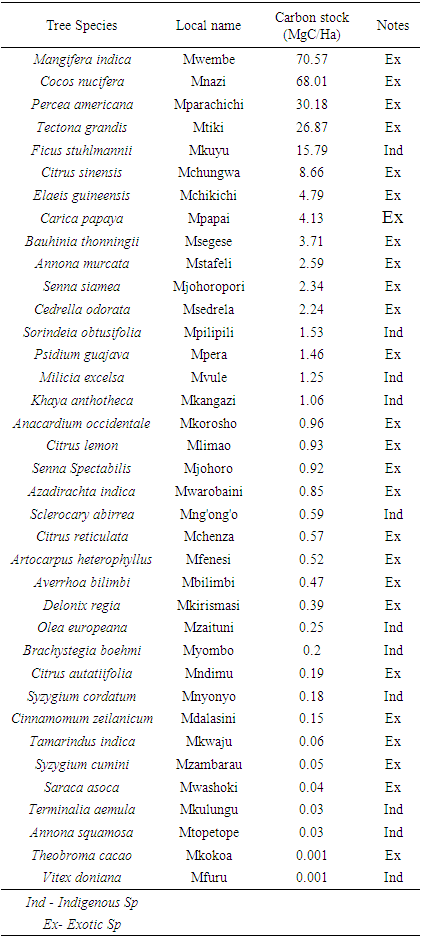-
Paper Information
- Paper Submission
-
Journal Information
- About This Journal
- Editorial Board
- Current Issue
- Archive
- Author Guidelines
- Contact Us
International Journal of Agriculture and Forestry
p-ISSN: 2165-882X e-ISSN: 2165-8846
2022; 12(1): 29-36
doi:10.5923/j.ijaf.20221201.03
Received: Mar. 4, 2022; Accepted: Mar. 26, 2022; Published: Jun. 13, 2022

Carbon Sequestration in Agroforestry as a Strategy for Climate Change Mitigation in Kilombero Cluster of SAGCOT
Lazaro E. Nnko 1, Japhet J. Kashaigili 2, Pantaleo K. T. Munishi 3, Gerald C. Monela 1, Paulo J. Lyimo 3, Nyemo A. Chilagane 2
1Department of Forest and Environmental Economics, Sokoine University of Agriculture, Chuo Kikuu, Morogoro, Tanzania
2Department of Forest Resources Assessment and Management, Sokoine University of Agriculture, Chuo Kikuu, Morogoro, Tanzania
3Department of Ecosystems and Conservation, Sokoine University of Agriculture, Chuo Kikuu, Morogoro, Tanzania
Correspondence to: Lazaro E. Nnko , Department of Forest and Environmental Economics, Sokoine University of Agriculture, Chuo Kikuu, Morogoro, Tanzania.
| Email: |  |
Copyright © 2022 The Author(s). Published by Scientific & Academic Publishing.
This work is licensed under the Creative Commons Attribution International License (CC BY).
http://creativecommons.org/licenses/by/4.0/

Agroforestry has been recognized as one of the land use systems with a high potential for carbon sequestration. Our knowledge of this potential in tropical countries such as Tanzania is however limited. To improve understanding of this potential, a study was conducted in Kilombero district, where agroforestry is widely practiced. We surveyed ninety households’ farms 90 agroforestry farmlands with different agroforestry systems and practices. Based on the minimum household farm a plot of 0.125ha was used for tree measurements in all households. In each plot, all trees with a diameter ≥ 5cm at breast height (DBH) were measured for diameter and height. Diameter tape and Suunto hypsometer were used to measure tree diameter and height respectively. Species-specific allometric models were used for specific trees and a general allometric model for trees without specific biomass models. Descriptive statistics using a Microsoft Excel spread sheet was used to summarize the data for central tendency and variability. A total of 37 agroforestry tree species from 16 families were recorded in the study area. Three agroforestry systems and four agroforestry practices with different potential for carbon sequestration and storage were identified including agrosilviculture, agrosilvopasture, silvopasture systems and home gardens, mixed intercropping, parkland and boundary planting practices. Agrosilvopasture sequestered the highest carbon of 115.3 Mg C ha-1 followed by Silvopasture, 81.5 Mg C ha-1 and Agrosilviculture, 55.7 Mg C ha-1. Home gardens agroforestry practices sequestered the highest carbon of 185.79 Mg C ha-1 followed by Parkland 26.75 Mg C ha-1, Boundary planting, 23.22 Mg C ha-1 and Mixed Intercropping, 17.79 Mg C ha-1. A fruit tree Mangifera indica contributed the highest carbon sequestration of all the tree species with 70.57 Mg C ha-1. It is concluded that Agrosilvopasture systems and home garden practices have more potential to sequester carbon than the rest of the systems and practices. Investment in Agro-silvopasture systems, home garden practices and fruit trees will play better a dual role of climate change mitigation and household food security with implications on the household economy.
Keywords: Carbon Sequestration, Climate change Mitigation, Carbon stock, Agroforestry system and practice
Cite this paper: Lazaro E. Nnko , Japhet J. Kashaigili , Pantaleo K. T. Munishi , Gerald C. Monela , Paulo J. Lyimo , Nyemo A. Chilagane , Carbon Sequestration in Agroforestry as a Strategy for Climate Change Mitigation in Kilombero Cluster of SAGCOT, International Journal of Agriculture and Forestry, Vol. 12 No. 1, 2022, pp. 29-36. doi: 10.5923/j.ijaf.20221201.03.
Article Outline
1. Introduction
- Agroforestry (AF) has been considered as a viable alternative to prevent and mitigate climate change. AF has been used to mitigate climate change by preserving existing trees on farmland and/or increasing the plantation of short-rotation or fast-growing trees on farmland [15]. Mitigating climate change through increased carbon sequestration in the soil can particularly become useful, especially when addressed in combination with other challenges that affect people's livelihoods, such as reversing land degradation and ensuring food security [5,12].Usually, potential carbon sequestration may occur in different land uses, including agricultural land use and forest land through improved land use management and conventions for land use [19]. The IPCC recognized that agroforestry systems and practices have a high potential for sequestering carbon under climate change mitigation strategies [15]. Carbon can be stored in agroforestry systems and practices both above and below ground biomass [34]. In that respect, agroforestry systems and practices accumulate more carbon than forest and pasture because they have both forestry and grassland sequestration and active storage patterns [43,48], but the sequestration potential of agroforestry depends on plant characteristics, tree species, age, crop, biodiversity, and tree density. It is also affected by structural configuration and management factors such as fertilization, residuals, and harvesting regime. These factors, together with agroecological conditions as well as soil characteristics in the area where the agroforestry systems and practices are implemented, influence above and below-ground carbon sequestration [34,21,26,2]. According to [21], if agroforestry systems and practices are to be used for climate change mitigation through carbon sequestration, then better information is required about above and below-ground biomass and carbon stock. The aim of this study was to determine the carbon stock in different agroforestry systems and practices and also to determine which systems and practices have the best potential for long term carbon sequestration.
2. Material and Methods
2.1. Description of the Study Area
- The study was conducted in the Kilombero District, Cluster of the SAGCOT, which is located in Morogoro Region between 8°15'0" S and 36°25'0" E with elevation ranging from 262 m to 550 m above mean sea level (Figure 1). Administratively, Kilombero District has five divisions, 19 wards and 46 villages. The district is bounded on the north by Kilosa District, on the south by Ulanga District, on the west by Iringa Region, and on the east by Lindi Region [51].
 | Figure 1. Location of the study area within Kilombero District |
2.2. Methods
- Pre-visiting (reconnaissance survey) was conducted as a means to pre-test the inventory (data capture) tool. This was also conducted so as to familiarize with the study area and observe the nature of the agroforestry systems and practices. The research design for this study was cross-sectional as data was collected at once without repetitions.
2.2.1. Sampling Procedure and Sample Size Determination
- Three villages were purposely selected based on the presence of agroforestry systems and practices. A random sampling procedure was adopted for selecting households with agroforestry systems and practices where the village registers were used as a sampling frame. For the forestry inventory in the farmlands, a systematic sampling procedure was adopted. The average size of farmlands (household land parcels) was 0.18ha (±0.016 SE). Therefore, a plot of 0.125 ha was adopted for farmland greater than 2ha. For the farmland with an area less than 2ha, the whole farm was considered a plot [9]. A total of 30 plots (households) were established in each village making a total of 90 households, selected randomly from the three villages. A minimum of thirty (30) sampling units have been established to be adequate for statistical inferences [3,42,27,32].
2.2.2. Data Collection
- At each sampling plot, all trees with minimum diameter at breast height (DBH) greater or equal to 5 cm were identified and measured for diameter and height but Cacao (Theobroma cacao) diameter were measured at 0.3m [28,55]. Tree DBH was measured using diameter tape and tree height was measured using Suunto hypsometer.
2.2.3. Data Analysis
- Information obtained from the biophysical survey, mainly inventory data, was recorded in Microsoft Excel for biomass calculation and carbon estimation. The data were analysed on the basis of systems and practices separately. Allometric equations were used to convert the field measurement attributes, mainly height and diameter, into stand biomass. Species-specific allometric models were used for trees a general allometric model was used for trees without specific equations. Most of these models have been developed for Tanzanian tree species and vegetation types (Table 1) [54,53,16,30,52,17]. Carbon stock was computed as the product of total biomass and a factor of 0.5 [44,57,58].
|
3. Results and Discussion
3.1. Results
3.1.1. On Farm Trees and Carbon Stock
- A total of 37 tree species from 16 families were recorded in the study area. Mangifera indica sequestered the highest carbon stock of 70.57 Mg C ha-1 followed by Cocos nucifera 68.01 Mg C ha-1. Theobroma cacao and Vitex doniana had the lowest carbon stock (Table 2).
|
3.1.2. Carbon Stock in Different Agroforestry Systems and Practices
- Three agroforestry systems and four agroforestry practices with different potential for carbon sequestration and storage were identified including agrosilviculture, agrosilvopasture, silvopasture systems and home gardens, mixed intercropping, parkland and boundary planting practices. Agrosilvopasture sequestered the highest carbon of 115.3 Mg C ha-1 followed by Silvopasture, 81.5 Mg C ha-1 and Agrosilviculture, 55.7 Mg C ha-1. Home gardens agroforestry practices sequestered the highest carbon of 185.79 Mg C ha-1 followed by parkland 26.75 Mg C ha-1, boundary planting, 23.22 Mg C ha-1 and mixed Intercropping, 17.79 Mg C ha-1.
 | Figure 2. Carbon stock in different agroforestry systems |
3.1.3. Carbon Stock in Different Agroforestry Practices
- Different practices contribute to biomass and carbon stock differently (Figure 3). The practice with the highest carbon sequestration was home gardening, which had 185.79 Mg C ha-1, followed by parkland, which had 26.75 Mg C ha-1, boundary, which had 23.22 Mg C ha-1, and mixed intercropping, which had 17.79 Mg C ha-1.
 | Figure 3. Carbon stock in different agroforestry practices |
3.2. Discussion
3.2.1. Carbon Stock in Tree Species
- Mangifera indica had the highest amount of biomass carbon of 70.57 Mg C ha-1 followed by Cocos nucifera with 68.01Mg C ha-1. The high amount of carbon in these species is explained by dominance as well as size (diameter at breast height). The species is grown for its fruits with increasing demand thus resulting in the species dominating the agricultural landscape. This is also true for palm and coconut trees which produce fruits and coconut juice respectively for both domestic and local market demand [29]. A study conducted in the Philippines on carbon sequestration revealed that Mangifera indica can sequester 100.71 Mg C ha-1 [20]. This is higher than the amount obtained in this study. In fact, [8] and [14] reported that DBH accounts for 95% of the total biomass, and in this study, Mangifera indica presents biomass and carbon stock, which can be due to its average diameter and height. Other species, like Theobroma cacao and Vitex doniana, had less carbon stock due to their smaller average diameter and height. The number of occurrences of trees in the plots can also be used to justify the amount of carbon sequestered by a particular species [20]. The top trees with the highest biomass were tree species used for food (Cocos nucifera), fruits (Mangifera indica and Persea americana), timber production, (Tectona grandis) and one mostly used for shade (Ficus stuhlmannii). The variety of species documented and observed in this study, displays the potential for agroforestry to enhance the resilience of farmers to the present and future climate risks. For example, farmers in both villages maintain varieties of trees for timber, fruits, and animal fodder to support livestock during drought. A similar study conducted in Kenya showed that the majority of small holder farmers maintain trees not only for food support but also for soil and water conservation [11,40]. There was a variable distribution of tree species across different agroforests. High tree species diversity was found in home gardens where multipurpose trees for different uses like animal fodder, shade, timber, and food are grown. For example, trees with a high frequency in the home garden were Mangifera indica, Cocos nucifera, Persea americana, Tectona grandis and Ficus stuhlmannii. Moreover, high economic value trees are widely spread in the farm lands/different agroforests.
3.2.2. Carbon Stock in Agroforestry Systems
- Results from this study show that agrosilvopasture agroforestry system has high carbon sequestration over silvopasture and agrosilviculture systems. Silvopasture holds the second potential for carbon sequestration. In agroforestry systems, carbon is stored in both below and above-ground biomass. Studies in India have shown that different agroforestry systems have a sequestration potential of 68 - 228 Mg C ha-1 [10,33], and these values may vary in different regions depending on biomass production. The integration of livestock and forests benefits both systems by reducing and offsetting greenhouse gas emissions from the agriculture sector. On the other hand, the presence of livestock lowers the animal’s emission level [35] by improving pasture quality, which can then reduce methane from enteric fermentation [7]. In addition, high carbon sequestration in agrosilvopasture is influenced by litter input on the soil surface [38]. The introduction of integrated crops, livestock, and forest systems enhances carbon sequestration due to the presence of different components that increase root volume and promote greater production of vegetal biomass [47]. In Kilombero, the silvopasture system presented the second potential for carbon storage of 81.5 Mg C ha-1. Geographic location, tree age, and management may as well influence the carbon stored by a system [34]. A study conducted in Latin America indicated that silvopasture systems can store about 0.31- 91.8 Mg C ha-1 [31]. This range reflects the heterogeneity of the silvopasture system, which differs in its design, species, and site conditions [31]. In some cases, species used in silvopasture are mostly consumed by animals as fodder, being either harvested or browsed by cattle. Therefore, standing biomass composed principally by branches and foliage remains low and sometimes leads to low carbon sequestration compared to other systems [31]. Agrosilviculture in Kilombero stores 55.7 Mg C ha-1 which is less compared to other identified systems. A study by [33] pointed out that the amount of carbon stored in agrosilviculture depends highly on the age of a tree and the tree species available. For example, the agrosilviculture of Dalbergia sissoo of 11-year age is able to accumulate 48 - 52 Mg C ha-1 [36]. The carbon dynamic in agrosilviculture is described by different operations on trees, such as pruning and thinning that regulates the height and canopy cover of the trees. This study also revealed that the low amount of carbon in agrosilviculture may be the result of the small number of trees on the farm land, since too many trees may have a negative impact on crop production.
3.2.3. Carbon Stock in Agroforestry Practices
- A number of studies have shown that agroforestry in the tropics has a higher carbon stock than any crop field or pasture [1,34]. The results indicate that the home garden leads in carbon sequestration with 185.79 Mg C ha-1. These results are highly influenced by the mixture of components of agroforestry, such as livestock, trees, and agricultural crops. In other ways, home gardens have been observed as a potential practice for carbon sequestration due to the fact that they sequester carbon above and below ground biomass, reduce fossil fuel burning by producing fuelwood that acts as a substitute, and reduces pressure on natural forest. Furthermore, there is no complete removal of biomass in the home gardens [13,23] increasing residual carbon in the system. Similarly, a study conducted in India shows that a home garden aged 12-17 years accumulates 55.8 - 162Mg C ha-1 [41]. According to a study on agroforestry practices conducted by [22], a home garden can sequester carbon at a rate of 68-228 Mg C ha-1 depending on species composition, soil, and climate. Mixed intercropping, which involves woody perennial and herbaceous crops, was observed to store 17.79 Mg C ha-1. The amount of carbon within the mixed intercropping is higher than that coming from the mono-cropping system due to the addition of a carbon pool in trees and increased soil carbon pool as a result of carbon input from litterfall and fine root turnover [37]. Mixed intercropping can store 121-125 Mg C ha-1 due to higher growth and assimilation rates [39]. Parkland practice was observed to store 26.75 Mg C ha-1. In parkland practice, unlike in mixed intercropping, trees were not arranged in accordance with crops but few trees were left on the cropland. A study conducted in Guinea showed that parkland carbon stock also ranged from 22 - 70.8 Mg C ha-1 [24]. Parkland agroforestry is very stable (long-standing) and has high carbon storage [46]. In boundary planting agroforestry practices, trees are planted purposely to mark farm boundaries or fencing. In this study, boundary planting agroforestry practice stored 23.22 Mg C ha-1. Boundary planting has a positive effect on soil characteristics, crop production, and carbon sequestration [1]. Furthermore, [18] indicated that boundary planting practices can have carbon storage ranging from 18.53 - 116.29 Mg C ha-1. Another study indicated a greater potential for carbon sequestration in boundary plantation of Populus deltoides and Eucalyptus hybrid [33]. In this study, carbon stock does not differ greatly from other studies, rather, the difference in the carbon stock can be explained by factors such as the allometric equations used, which could be a limitation resulting in large variation in such an estimate [45]. Non-removal of trees in the field could also be the source of the high amount of carbon stored by trees. In this study, many trees observed were for various purposes, such as food, fruits, shade, wind break, and boundary, hence they were maintained for a long time, resulting in a high amount of carbon stocks.
4. Conclusions
- Agroforestry systems and practices play an important role in climate change mitigation. This study concludes that there are benefits in terms of carbon sequestration from the implementation of agroforestry systems and practices. In this study, we also found that carbon storage is determined by the components of farmlands. Fruit trees were the most abundant trees, suggesting multipurpose uses and economic benefits. This combination makes trees on farms more permanent and a result of long-term carbon storage in large amounts due to the size growth of trees over long periods. Therefore, trees growing on the farm to meet local food and fuel needs concurrently contribute to global climate regulation needs. Agrosilvopasture systems and home garden practices are the best when it comes to climate change mitigation through carbon sequestration on the farm. Agrosilvopasture systems and home garden practices therefore have more potential to sequester carbon than the rest of the systems and practices. Investment in Agro-silvopasture systems, home garden practices and fruit trees will play better a dual role in climate change mitigation and household food security with implications on household economy.
ACKNOWLEDGEMENTS
- The authors are grateful to Development Corridor Partnership (DCP) for funding this study. Second, we would like to thank the staff from the College of Forestry, Wildlife and Tourism at the Sokoine University of Agriculture for their total support. We would also like to extend our gratitude to Kilombero District agroforestry farmers for providing room for this study to be undertaken on their farms. We would like to thank Profs. Emmanuel Nzunda from SUA, Neil Burgess from WCMC and Mr. Peter Mzirai from SUA for their guidance and cooperation during all stages of the development of this article.
 Abstract
Abstract Reference
Reference Full-Text PDF
Full-Text PDF Full-text HTML
Full-text HTML
